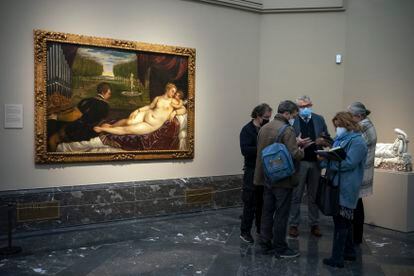“Friend, the time has come for the greatest effort in painting that has been offered in Madrid, and it is because His Majesty has determined that the paintings be made for the church of San Francisco el Grande [of] this court, and he has deigned naming me."
The letter is dated July 25, 1781. The painter Francisco de Goya writes to his friend Martín Zapater one of the many missives of a correspondence that would later become a book, and that testify to a chapter in the history of Spain, to tell him that after his controversial and harsh departure from Zaragoza, he has found a job in Madrid that will make him a court painter through the mediation of the Count of Floridablanca.
Goya has to paint one of the seven chapels of the Royal Basilica of San Francisco el Grande in the capital and will be measured against other great painters of the time, many already consecrated, such as Andrés de la Calleja, Antonio González Velázquez, Francisco Bayeu and Mariano Salvador Maella.
But first, he will have to present some sketches of
The preaching of Saint Bernardino of Siena before Alfonso V of Aragon,
the theme you have chosen.
In his letters he calls them “blotches” and “little blurs”.
Centuries later, those sketches hang in the renovated room 36 of the Prado Museum as historical proof of the author's artistic quality even in his first brushstrokes of a painting.
Another novelty in the art gallery is the new arrangement of the
pestles,
which now dialogue with a Titian Venus.
More information
The most important Goya exhibition ever held abroad arrives in Basel
The sketches that are now exhibited in the Madrid art gallery had only been seen on a few occasions.
The first of them was shown in 1900 in Madrid and in 1920 and 1921 in London.
The second, more elaborate, with modifications, is presented for the first time.
They are not unknown pieces —not only were they recorded in the letters to his friend Zapater, without the existence of black and white photographs taken between the beginning and the middle of the last century—, but in the following decades information on their whereabouts was lost.
In addition, they are documented in 1867 in the collection of the VII Marquis de la Torrecilla, direct ancestor of Tatiana Pérez de Guzmán el Bueno, whose foundation, dedicated to the conservation of artistic and educational heritage,
She is responsible for the fact that today they hang in the Prado in an agreement with the institution by which the drawings have also been restored.
"It is not known how the works came to Tatiana's grandfather, who is almost a contemporary of Goya," explains Álvaro Matud, academic director of the Foundation.
"It is his first great altar painting," Manuela Mena, art historian and Goya expert, explains to EL PAÍS, who was one of the first to see the sketches when it still belonged to the Prado.
“They are religious works that in Goya's production are just as important as the rest.
For him there was no difference.
That is why Gudrun Maurer, current curator of 18th-century Spanish Painting and Goya at the Prado Museum, has placed them next to other pieces on this theme, such as
Christ crucified
of 1780, with which the artist entered the Royal Academy of San Fernando.
This room, like the other three remaining, is the first example of the reorganization of part of the Prado's permanent collection, which will be the axis of the art gallery's programming this year.
Walls have been thrown, "from the 20th century, not from Villanueva [in reference to Juan de Villanueva, architect of the original building]", explains Miguel Falomir, director of the Prado, about the works.
There is more space, more light and therefore more air for these large works to breathe.
In this room dedicated to religion there are also three other sketches of altar paintings for the cathedrals of Seville and Toledo and for private clients.
In all the examples, but above all in the sketches for the Basilica, as Mena recalls, “Goya's immense capacity for variation within his style is shown;
his way of entering into the personality of those represented even in a small sketch;
the Renaissance composition with a figure above the others, those below listening to Saint Bernardino”.
The final result can be seen as soon as you enter the Madrid church, on the left.
A work that fixes the eyes of the visitor in this imposing temple.
Another way to look at the
majas
'Las Majas' by Goya in its new room at the Prado Museum.Andrea Comas
Before reaching the religious sketches, the Prado has reoriented the visitor's gaze towards
Goya's
majas .
The Naked Maja
and
The Clothed Maja
, side by side, hang in a new room and are accompanied by the painting
Venus Recreating herself with Love and Music,
by Titian, painted around 1555. This is the way in which the museum has recreated the decoration of one of the cabinets of Manuel Godoy's palace where Goya's women looked at each other with
Velázquez 's
Venus in the mirror .
"The lying nude is a pictorial subgenre that was born in the 16th century and that nurtured Goya's art", explained Falomir, about this new dialogue between women.
The painting 'Venus recreating herself with Love and Music', by Tiziano.Andrea Comas
The rearrangement of this part of the permanent collection is completed with a tour of the portraits painted by Goya from the 1780s to the 1800s, showing the panorama of clients who sought out this artist who soon became the most important portraitist in the court of his time.

